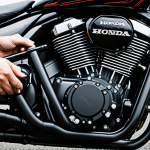Understanding Clutch Pedal Free Play
Clutch pedal free play is a critical component of maintaining a smooth driving experience, especially in vehicles with a manual transmission. It refers to the small amount of movement in the clutch pedal before the resistance is felt. This gap ensures that the clutch mechanism is not engaged prematurely or partially when the pedal is at rest.
Correct free play adjustment is vital for optimal clutch performance and overall vehicle operation. Insufficient free play can cause the clutch to slip, leading to increased wear and potential damage to components. Conversely, excessive free play might cause difficulty in changing gears, potentially stalling the vehicle. Both scenarios can lead to decreased performance and higher repair costs.
This might interest you : Mastering Drug-Impaired Driving Laws: An In-Depth Guide to UK Regulations and Penalties
Automakers generally provide specific free play specifications for their models, which can often be found in the vehicle’s service manual. While specifications can vary, a typical recommended free play might range from 1 to 1.5 inches. Adhering to these specifications helps maintain clutch longevity and ensures a smoother driving experience. Knowing how to check and adjust free play can empower DIY enthusiasts in maintaining their vehicles efficiently, safeguarding both performance and longevity.
Tools Required for Adjustment
When embarking on a DIY car maintenance project like adjusting clutch free play, having the right tools is paramount. The essential tools include a set of wrenches—especially open-end or box wrenches—as they facilitate gripping and turning nuts and bolts effectively. Feeler gauges are crucial for measuring the specific gap required during the adjustment process.
In the same genre : Exploring the Impact of Vehicle Weight on Braking Performance on the UK’s Steepest Descents
Alternative tools might be helpful in certain scenarios. For instance, if wrenches are unavailable, an adjustable spanner or pliers can sometimes be used, albeit with caution to avoid damaging the components. It’s also advisable to have a flashlight handy for illuminating hard-to-see areas.
Safety gear plays an indispensable role in ensuring a secure work environment. Wearing gloves protects your hands from sharp edges and hot surfaces. Additionally, using goggles shields your eyes from potential splashes or flying debris.
Before starting any work, make sure your vehicle is on a flat surface, and engage the parking brake to prevent any unexpected movement. Remember, always disconnect the battery to avoid any electrical surprises. Following these precautions ensures the adjustment is done safely and efficiently, ultimately contributing to a smoother driving experience.
Step-by-Step Guide to Adjusting Clutch Free Play
Adjusting the clutch pedal requires careful attention to detail, ensuring smoother transitions in manual cars. This guide aids you in mastering this adjustment process efficiently.
Preparing Your Vehicle for Adjustment
Before embarking on the adjustment journey, ensure your vehicle is parked on a flat surface. This stabilizes the car and improves safety. Depress the clutch pedal to identify the current free play. It’s important to mark the pedal’s resting position to gauge changes post-adjustment.
Making the Necessary Adjustments
Begin by locating the clutch cable near the gearbox. Adjust it using an open-end wrench to increase or decrease the free play as needed. A typical adjustment involves turning the nuts clockwise or counterclockwise, impacting the pedal’s feel. Utilize a feeler gauge to confirm adjustments within specified ranges, typically between 1 to 1.5 inches.
Final Checks and Testing
After completing the adjustment, return the pedal to its default position and observe for any anomalies. Testing the vehicle’s driving performance under different conditions affirms the adjustment’s accuracy. Regular monitoring of free play is paramount for sustaining vehicle health.
Troubleshooting Common Issues
When dealing with clutch problems, understanding the common issues linked to clutch pedal free play is vital. Symptoms of improper adjustments can include difficulty shifting gears, the clutch slipping, or a pedal that feels too tight or too loose. Recognizing these signs early can prevent further damage.
Step-by-Step Troubleshooting
-
Difficulty Changing Gears: If switching gears is challenging, it could indicate excessive clutch pedal free play. Check and adjust the free play to solve this issue, ensuring it falls within the recommended range.
-
Clutch Slipping: This happens when the clutch fails to fully engage. Insufficient free play might be the cause. Re-adjust the pedal to restore proper engagement.
-
Stiff Pedal: A stiff pedal may result from too little free play. Increase the gap to ease pedal movement and enhance performance.
Immediate DIY fixes could solve these problems, but persistent issues may require professional intervention. Consult a mechanic if you’re unsure, as clutch performance is crucial for safe vehicle operation. Balancing DIY enthusiasm with expert advice ensures the longevity of your manual transmission system.
Visual Aids for Clutch Adjustments
Understanding clutch pedal adjustments can sometimes be challenging, but visual aids offer invaluable help. By using clutch adjustment diagrams and instructional videos, the adjustment process becomes more accessible and less daunting, especially for the DIY enthusiast.
Visual aids, such as diagrams, highlight each component of the clutch system, clarifying where adjustments should take place. This can aid in identifying the free play adjustment points, ensuring the process is exact. Diagrams also provide a visual step-by-step guide that can prevent mistakes that might arise from misinterpretation of textual instructions alone.
Instructional videos take this a step further by demonstrating the adjustment process in real-time. Seeing an expert handle the tools, adjust the pedal, and verify the results helps build confidence for those unfamiliar with manual transmission maintenance.
When using these aids, pay close attention to the tools and techniques displayed. This reinforces learning through observation, providing a practical understanding of theory. Combining clear visuals with detailed audio explanations results in a more comprehensive grasp of how to efficiently adjust the clutch pedal, ensuring reliable vehicle performance.
Frequently Asked Questions
Navigating the complexities of clutch pedal adjustments often leads to questions. Here are detailed insights into common concerns, enhancing your understanding of manual transmission maintenance.
1. What is clutch pedal free play, and why is it important?
Clutch pedal free play is the slight movement before resistance in the pedal. It prevents premature engagement, ensuring efficiency and longevity.
2. How often should I check and adjust clutch pedal free play?
Regular checks—ideally every 10,000 miles—prompt effective vehicle operation. However, with noticeable gear or pedal issues, immediate attention is advised.
3. Can I adjust the clutch pedal free play myself?
Absolutely. With basic tools and understanding, you can perform a free play adjustment. Refer to diagrams and videos for a step-by-step guide.
4. Are there risks to incorrect clutch free play adjustments?
Yes. Incorrect adjustments can lead to gear shifting difficulties or clutch slippage, increasing wear and repair costs.
For further clarity, consider professional advice if you’re uncertain. Resources like service manuals provide additional guidance. This empowers you to address clutch pedal issues confidently, optimizing performance and extending your vehicle’s lifespan.




